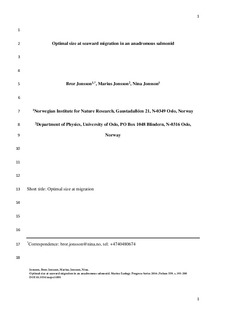Optimal size at seaward migration in an anadromous salmonid
Journal article, Peer reviewed
Accepted version

Åpne
Permanent lenke
http://hdl.handle.net/11250/2478307Utgivelsesdato
2016Metadata
Vis full innførselSamlinger
- Publikasjoner fra CRIStin - NINA [2364]
- Scientific publications [1392]
Sammendrag
In this study, the probabilistic reaction norm was calculated for length at different ages of smolting before seaward migration of Atlantic salmon Salmo salar spawning in the Norwegian River Imsa. The reaction norm was compared with the optimal length at smolting estimated as the product of survival and female fecundity on the return, given their length at smolting. Logistic regression analysis on pre-migratory and migratory fish was used to estimate the probabilistic reaction norm. Length at 50% probability of smolting varied between 11.5 cm and 13.4 cm for age groups 1 to 3 yr with a minimum at Age-2. The estimated optimal length at smolting exhibited a maximum at 13.5 cm. Fecundity of adult females was not significantly affected by their length at smolting, making survival the chief variable influencing the optimal smolt size. The results lend support to the hypotheses that body length at 50% probability of seaward migration was similar for all smolt-age-groups independent of growth, and that mean length at each age of the young fish in fresh water reflected the probability of seaward migration. The slight difference between estimated optimal length at smolting and size at 50% probability of smolting may be chiefly caused by size dependent mortality at sea because of the tagging and larger pre-migratory mortality of young than older juveniles in the river. Thus, size appears crucially important for when to migrate. Migration ecology · Anadromy · Probabilistic reaction norm · Reproductive rate · Logistic regression · Smolt length · Atlantic salmon · Salmo salar